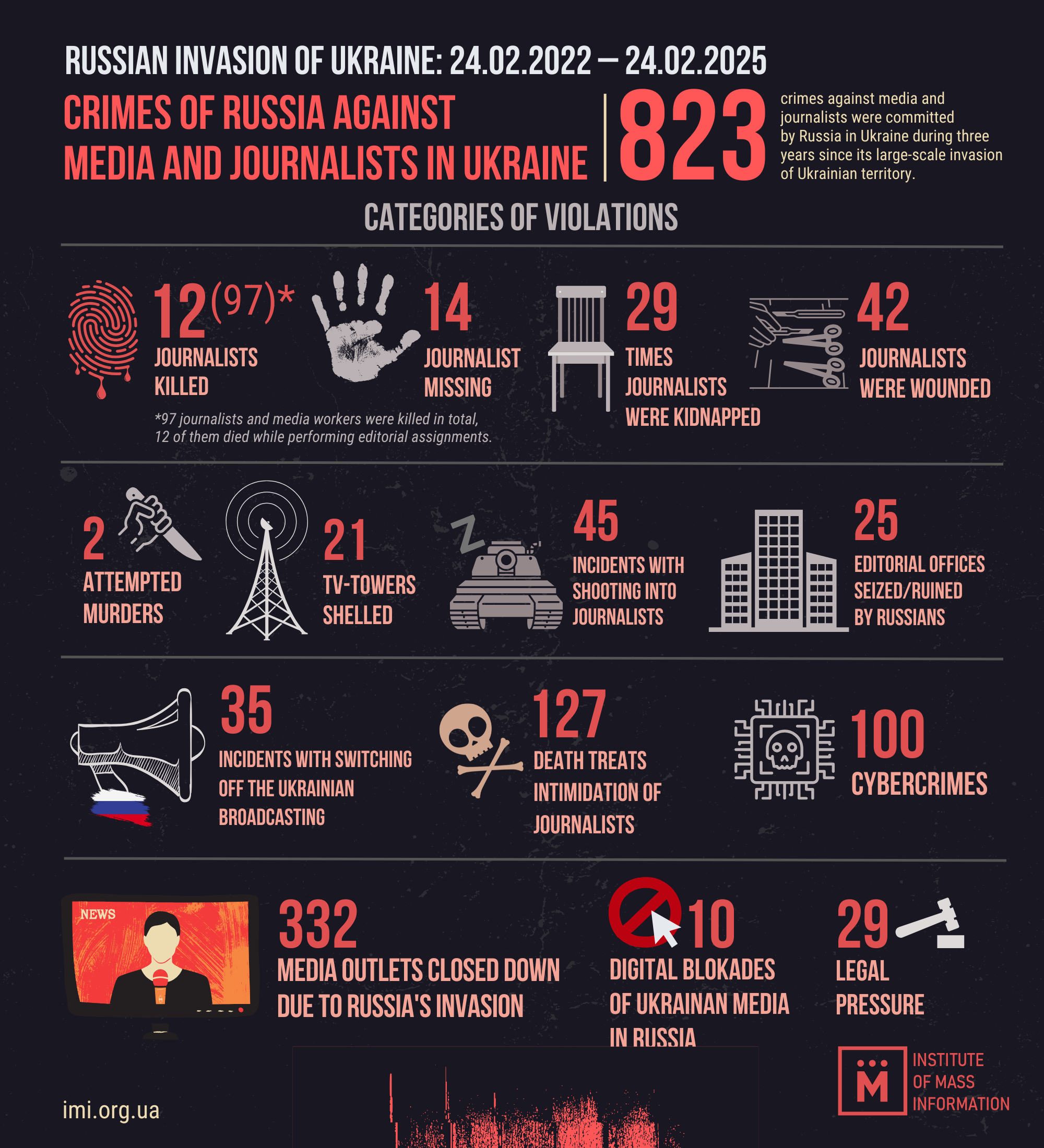In the three years since the start of the full-scale invasion, Russia has committed 823 crimes against journalists and the media in Ukraine, as evidenced by the Monitoring Study of Russia’s Crimes Against Journalists and the Media, which the Institute of Mass Information has been carrying out since the first day of Russia’s invasion of Ukraine.
Here are the main crimes against journalists and the media committed by Russia on Ukrainian land:
- murdering journalists (97);
- kidnapping journalists (29);
- firing at (45) and injuring journalists (42);
- harassment, death threats and intimidation of journalists (127);
- damage to media offices from shelling (25);
- shelling strikes on TV towers (21);
- disabling Ukrainian broadcasting and replacing it with Russian propaganda (35);
- cyber crimes (100);
- media outlets shutting down due to the financial and staffing crisis caused by the full-scale Russian aggression (332);
- legal pressure (29).

Three years of the full-scale war: Russia commits 823 crimes against journalists and the media in Ukraine
Russia killed 97 media workers in Ukraine in the three years since the start of the full-scale invasion. Of those, 12 journalists died while reporting, 72 wree killed in action as combatants, and 13 died by Russian shelling or torture.
In the third year of the full-scale invasion, the IMI recorded two cases of media workers being killed while reporting: Ukrainian journalist Victoria Roshchyna (died in Russian custody) and Reuters safety advisor Ryan Evans (killed in a Russian shelling strike on a Kramatorsk hotel).
A total of 104 media workers have been killed since the beginning of the Russia–Ukraine war in 2014, with 15 dying while reporting.
At least 30 civilian Ukrainian media workers and one journalist turned combatant are illegally held in Russian custody. These are journalists whom Russia have been detaining since 2016 and through 2024. Four of the hostages are women. Ukraine managed to release four media workers from Russian custody as part of an prisoner swap in 2024: one civilian (Nariman Celal) and three service members (Maksym Butkevych, Oleksandr Hudilin, Roman Borshch).
According to the IMI, a total of at least 112 Ukrainian and foreign journalists have been detained or taken hostage by Russian and pro-Russian forces since in 2014. Many of them are still in prison. Russia has charged or is charging many media workers with involvement in terrorist organizations, accusing them of terrorism or spying for Ukraine. Many of them have been tortured, abused, and beaten.
Over the third year of the full-scale invasion, the IMI recorded five cases of media workers being kidnapped. Namely, the RIA Melitopol journalist Anastasia Hlukhovska and the Telegram channel administrators from occupied Melitopol, Vladyslav Hershon and Yevhen Ilchenko, are still held hostage by Russia. In Kakhovka, Russian forces kidnapped the local journalist Zhanna Kiselyova, who was later released. The Russians also detained and then released Luhansk oblast journalist Volodymyr Martynov.
In the three years of the full-scale invasion, the IMI has recorded at least 41 incidents where journalists were injured and at least 45 cases of Russian troops targeting journalists with fire. Journalists with Ukrainian and foreign media outlets have come under fire, suffering concussions, bone fractures, limb injuries, and shrapnel wounds as a result of Russian shelling.
Furthermore, the IMI recorded at least 100 cyber attacks on Ukrainian news websites in the three years of Russia’s full-scale war against Ukraine. The Russians attacked the websites of both national and regional media outlets, as well as TV broadcasting, and tried to use them to disseminate their propaganda.
At least 332 media outlets have closed or suspended operations over the three years of the full-scale invasion. These are just the public data; the IMI experts suggest that the actual number of media outlets that had to close down is higher. This issue mostly affected the regions closest to the front lines. Overall, the Russian war has caused the closure of media outlets in nearly all oblasts. The main reasons for media outlets closing down were the temporary occupation of territories and the war-related financial difficulties.
In two years since the start of the full-scale invasion, Russia committed 567 crimes against journalists and media outlets in Ukraine. 497 crimes were committed in the first year of the full-scale invasion.
Read the full monitoring here.
The Institute of Mass Information (IMI) is a Ukrainian non-governmental media organization that has been operating since 1996. The IMI defends the rights of journalists, analyzes the media field and covers media-related events, fights propaganda and disinformation and has been providing media outlets with safety gear for trips to the combat zone since the start of the Russo–Ukrainian war in 2014.
The IMI carries out Ukraine’s only freedom of speech monitoring and keeps a list of high quality and sustainable online media outlets, documents Russia’s crimes against the media committed in the course of the war on Ukraine. The IMI has representatives in 20 oblasts of Ukraine and a network of “Mediabaza” hubs to provide journalists with continuous support. The IMI’s partners include Reporters Without Borders and Freedom House; the organization is a member of the International Organization for the Protection of Freedom of Expression (IFEX).
